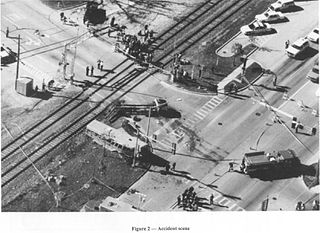
Grainger County is a county located in the U.S. state of Tennessee. As of the 2020 census, the population was 23,527. Its county seat is Rutledge. Grainger County is a part of both the Knoxville Metropolitan Statistical Area and Morristown Metropolitan Statistical Area.

Rutledge is a city in and the county seat of Grainger County, Tennessee. The city is part of both the Knoxville metropolitan area and the Morristown metropolitan area. As of the 2020 census, the city had a total population of 1,321.

Bean Station is a town split between the counties of Grainger and Hawkins in Tennessee, United States. As of the 2020 census, the population was 2,967. It is part of the Kingsport, Knoxville, and Morristown metropolitan statistical areas.

The 1995 Fox River Grove bus–train collision was a grade crossing collision that killed seven students riding aboard a school bus in Fox River Grove, Illinois, on the morning of October 25, 1995. The school bus, driven by a substitute driver, was stopped at a traffic light with the rearmost portion extending onto a portion of the railroad tracks when it was struck by a Metra Union Pacific Northwest Line train en route to Chicago.

U.S. Route 11W (US 11W) is the western branch of US 11 from the twin cities of Bristol, Tennessee/Bristol, Virginia, where US 11 splits into US 11E and US 11W, to Knoxville, Tennessee, where the two highways rejoin. The highway serves the Appalachia region's Ridge-and-Valley section of East Tennessee, bounded by the Clinch Mountain ridge to the north and the Holston River to the south. US 11W from Bristol to Bean Station and Blaine to Knoxville are designated as part of the National Highway System.

U.S. Route 11E (US 11E) is a divided highway of US 11 in the U.S. states of Tennessee and Virginia. The United States Numbered Highway, which is complemented by US 11W to the north and west, runs 120.94 miles (194.63 km) from US 11, US 11W, and US 70 in Knoxville, Tennessee, north and east to US 11, US 11W, US 19, and US 421 in Bristol, Virginia. US 11E connects Knoxville and the twin cities of Bristol, Virginia, and Bristol, Tennessee, with the East Tennessee communities of Morristown, Greeneville, and Johnson City. The U.S. Highway runs concurrently with US 70 and US 25W east of Knoxville, US 321 from Greeneville and Johnson City, and both US 19W and US 19 between Johnson City and Bristol. US 11E also has an unsigned concurrency with State Route 34 (SR 34) for almost all of its course in Tennessee.

U.S. Route 25E (US 25E) is the eastern branch of US 25 from Newport, Tennessee, where US 25 splits into US 25E and US 25W, to North Corbin, Kentucky, where the two highways rejoin. The highway, however, continues as US 25E for roughly two miles (3.2 km) until it joins Interstate 75 (I-75) in the Laurel County community of North Corbin at exit 29. The highway serves the Appalachia regions of Kentucky's Cumberland Plateau and the Ridge-and-Valley section of East Tennessee, including the urbanized areas of Corbin and Middlesboro in Kentucky and Morristown in Tennessee.

Interstate 81 (I-81) is part of the Interstate Highway System that runs 855.02 miles (1,376.02 km) northward from Dandridge, Tennessee, to the Thousand Islands Bridge at the Canadian border near Fishers Landing, New York. In Tennessee, I-81 serves the northeastern part of the state, running 75.66 miles (121.76 km) from its southern terminus with I-40 in Dandridge to the Virginia state line in Bristol. The route serves the Tri-Cities region of the state and the eastern parts of the Knoxville metropolitan area, terminating about 35 miles (56 km) east of Knoxville. I-81 bypasses most cities that it serves, instead providing access via interchanges with state and federal routes. It remains in the Ridge-and-Valley topographic region of the Appalachian Mountains for its entire length in Tennessee, and runs in a northeast to southwest direction.
The Tennessee Coach Company (TCC) was a regional highway-coach carrier, founded in 1928 and based in Knoxville, Tennessee, USA. It was in operation until 1976, when it became merged into the Continental Tennessee Lines, a subsidiary of the Transcontinental Bus System, called also the Continental Trailways. Continental Trailways was by far the largest member company in the Trailways trade association, which was then named the National Trailways Bus System.

U.S. Route 11 (US 11) in the U.S. state of Tennessee travels from the Georgia state line in Chattanooga to Knoxville, where it then splits into US 11E and US 11W. These two highways then travel to the Virginia state line near Kingsport and Bristol. During its length, it shares concurrencies with State Route 2 (SR 2) and SR 38.

State Route 70 is a state-maintained highway in East Tennessee, beginning at the border with North Carolina in the midst of the Cherokee National Forest and the Great Smoky Mountains and ending at the Virginia border in the extremely rural and mountainous terrain of Hancock County.

State Route 347 is a state-maintained, secondary highway in eastern Tennessee, beginning at I-26 in the Rock Springs community of Kingsport and ending at the intersection of US 11W and SR 70 in Rogersville.
The Snow Hill school bus collision was a vehicle accident that occurred on May 31, 1985, on US 13 near Snow Hill, North Carolina. Four vehicles were involved, including a school bus operated by the Greene County Schools. Six students and Carson Lee Conger, 27, of Norfolk, Virginia, were killed. The remaining 24 persons in the accident suffered injuries ranging from minor to critical.

Mooresburg is a census-designated place (CDP) and an unincorporated town in Hawkins County, Tennessee. Its population was 941 as of the 2010 census. It is located along U.S. Route 11W between Rogersville and Bean Station.

State Route 126 is a 24.6-mile-long (39.6 km) state highway that travels through Sullivan County in East Tennessee. It connects Kingsport and Bristol.

Phipps Bend Nuclear Plant was a planned nuclear power generation facility that was to be constructed and operated by the Tennessee Valley Authority (TVA) in unincorporated Hawkins County, Tennessee. Proposed to house two reactor units, the power plant was estimated to cost $1.6 billion when it was first planned in late 1977, provide a generating capacity of 2,600,000 kilowatts. Following negative public reactions towards nuclear energy following the Three Mile Island accident and a decreasing demand for power due to regional economic decline, the TVA's board of directors voted to defer further construction of the power plant. By 1981, the plant was 40% complete and an estimated $1.5 billion in planning, engineering, and construction costs had accumulated. Construction never resumed, and the project was canceled overall in 1982 due to lower load growth than forecast. By the project's cancellation, the TVA had amassed over $2.6 billion in spending for the incomplete nuclear facility. After being auctioned off by the TVA in 1987, the land acquired for the plant would be under the ownership of Hawkins County's industrial development board, who converted most of the site into an industrial park. A 1 MW solar farm was built at the site in 2017.

Tesla Autopilot is an advanced driver-assistance system (ADAS) developed by Tesla that amounts to partial vehicle automation. Tesla provides "Base Autopilot" on all vehicles, which includes lane centering and traffic-aware cruise control. Owners may purchase an upgrade to "Enhanced Autopilot" (EA) which adds semi-autonomous navigation on limited access roadways, self-parking, and the ability to summon the car from a garage or parking spot. The company claims the features reduce accidents caused by driver negligence and fatigue from long-term driving. Collisions and deaths involving Tesla cars with Autopilot engaged have drawn the attention of the press and government agencies.

The 2020 Pennsylvania Turnpike crash occurred in Mount Pleasant, Pennsylvania, on the Pennsylvania Turnpike in icy conditions at around 3:40 am on January 5, 2020. It was sparked by a 52-passenger tour bus traveling downhill, which struck an embankment and flipped on its side, causing a chain-reaction crash of two UPS trucks, a FedEx truck, and at least one other vehicle. Five people were killed, at least 60 people were injured, and an 86-mile (138 km) stretch of the Pennsylvania Turnpike was shut down in both directions as the crash was being investigated.

The 1990 Interstate 75 fog disaster was a traffic collision that occurred on the morning of December 11, 1990, on a section of Interstate 75 (I-75) near Calhoun, Tennessee, during dense fog which obscured the visibility of motorists. The collisions occurred in an area where fog is common and had been the site of previous multi-vehicle collisions caused by poor visibility. It consisted of a series of multi-vehicle collisions that ultimately involved 99 vehicles, and resulted in 12 deaths and 42 injuries. It was reportedly the largest motor vehicle collision in United States history when it occurred, in terms of the number of vehicles, and was the largest and second deadliest vehicle accident in Tennessee history behind the 1972 Bean Station bus-truck collision, which killed 14. The disaster resulted in multiple safety improvements to the section of I-75 where the collision occurred.

On December 23, 1988, a tractor-trailer tanker truck hauling liquefied propane crashed on an exit ramp at the Interstate 40/Interstate 240 (I-40/I-240) interchange in downtown Memphis, Tennessee, US. The crash ruptured the tank; the leaking gas exploded, setting multiple vehicles and structures on fire. The explosion propelled the tank 125 yards (114 m) into a residential complex and started additional fires. The accident caused nine deaths and ten injuries. The interchange where the accident occurred was considered unsafe and poorly designed, and had been the site of several previous accidents; it was completely rebuilt in the 2000s.





















